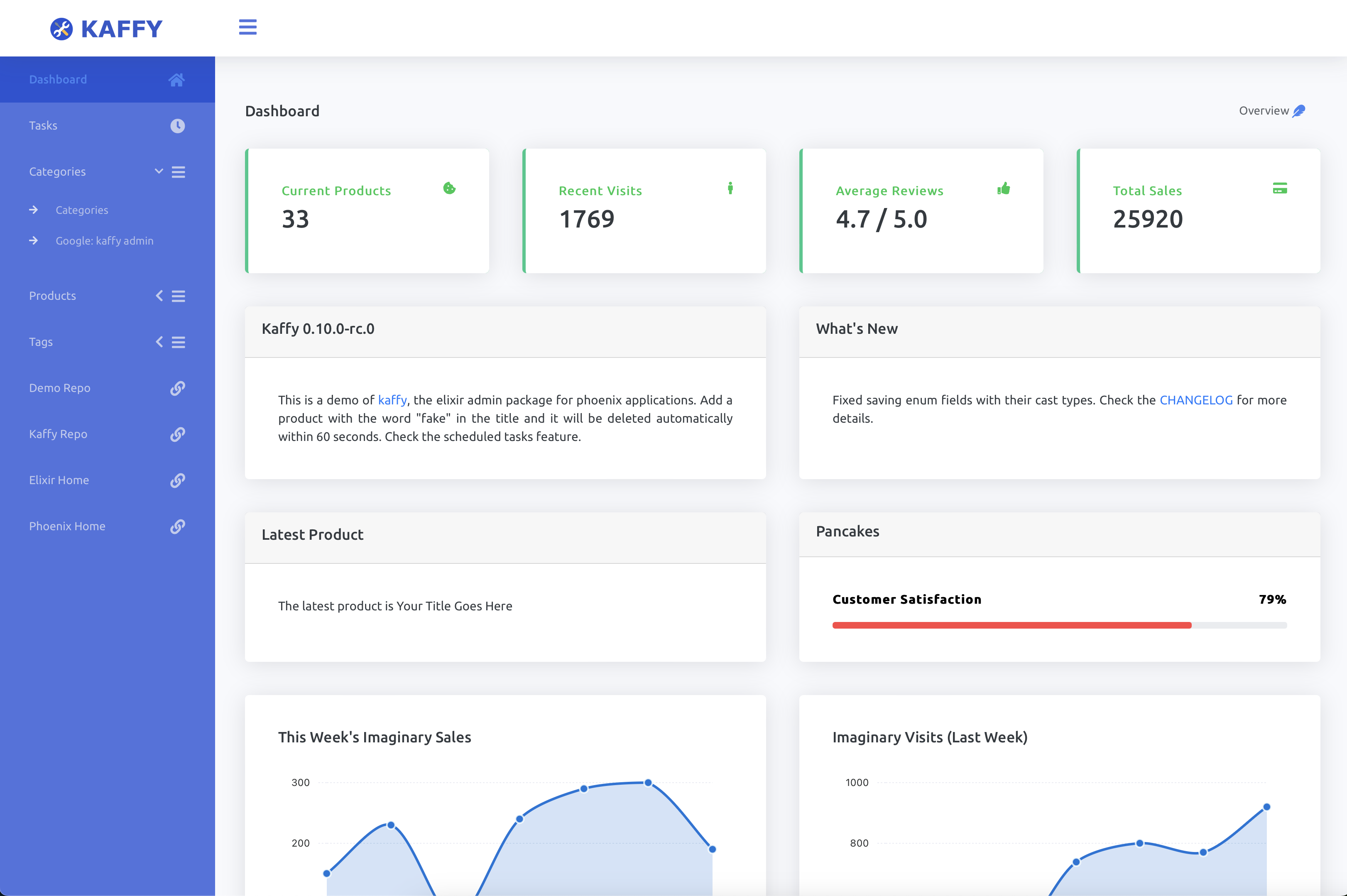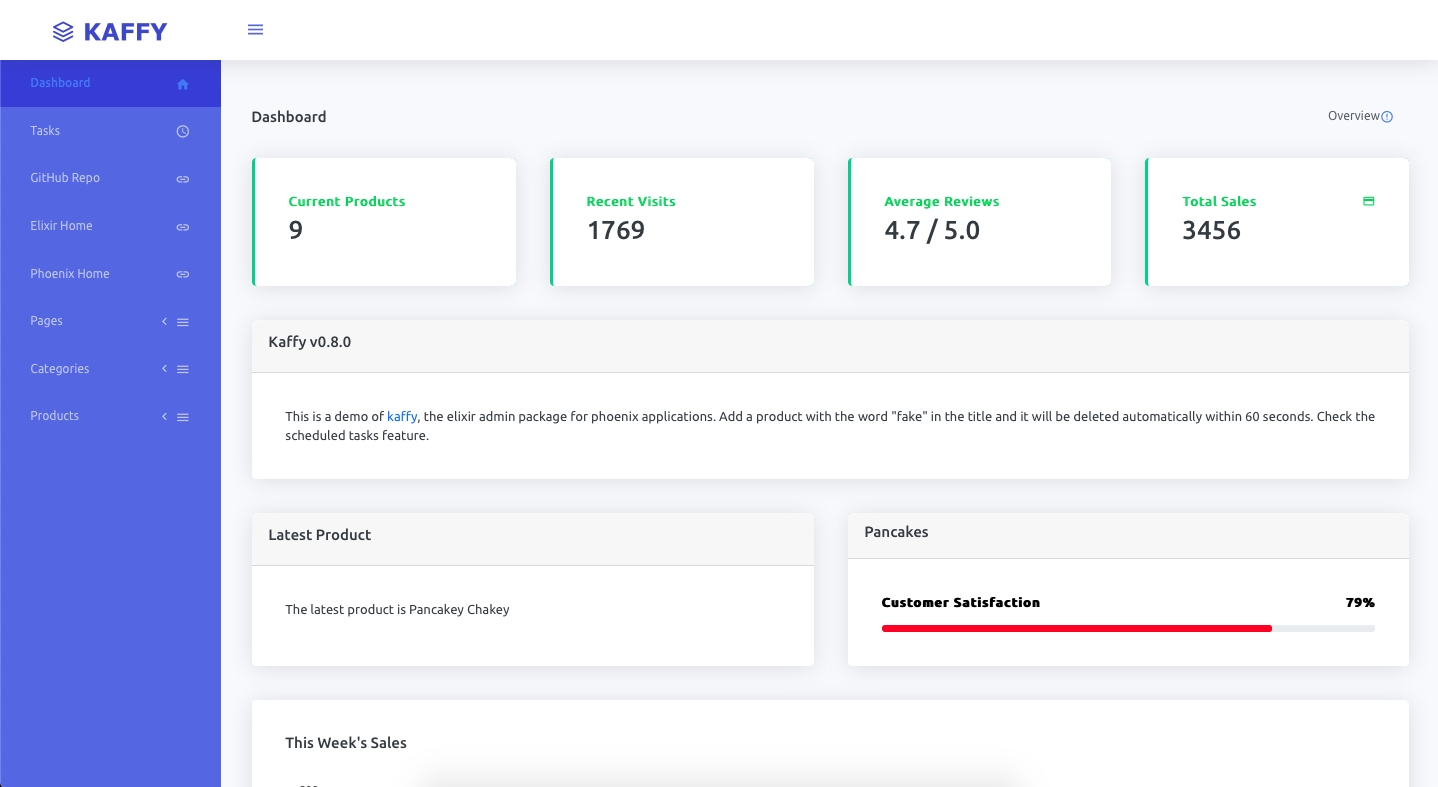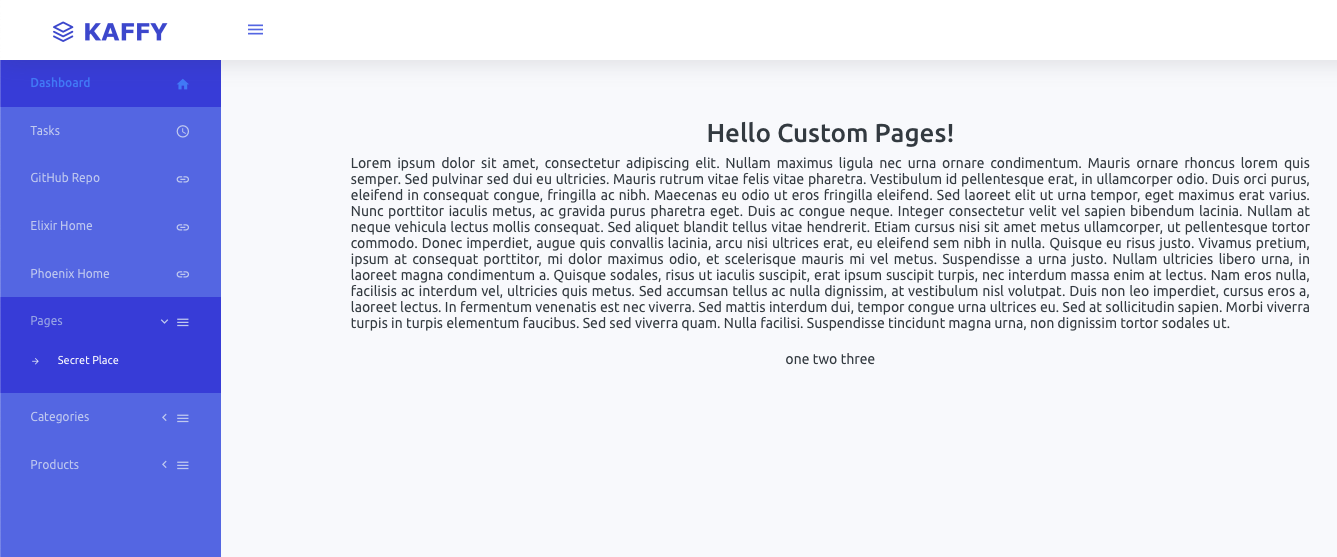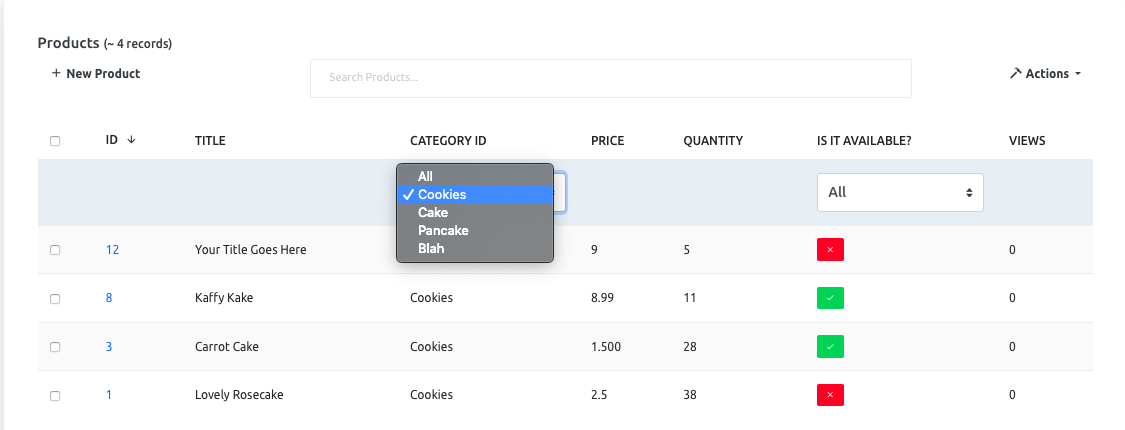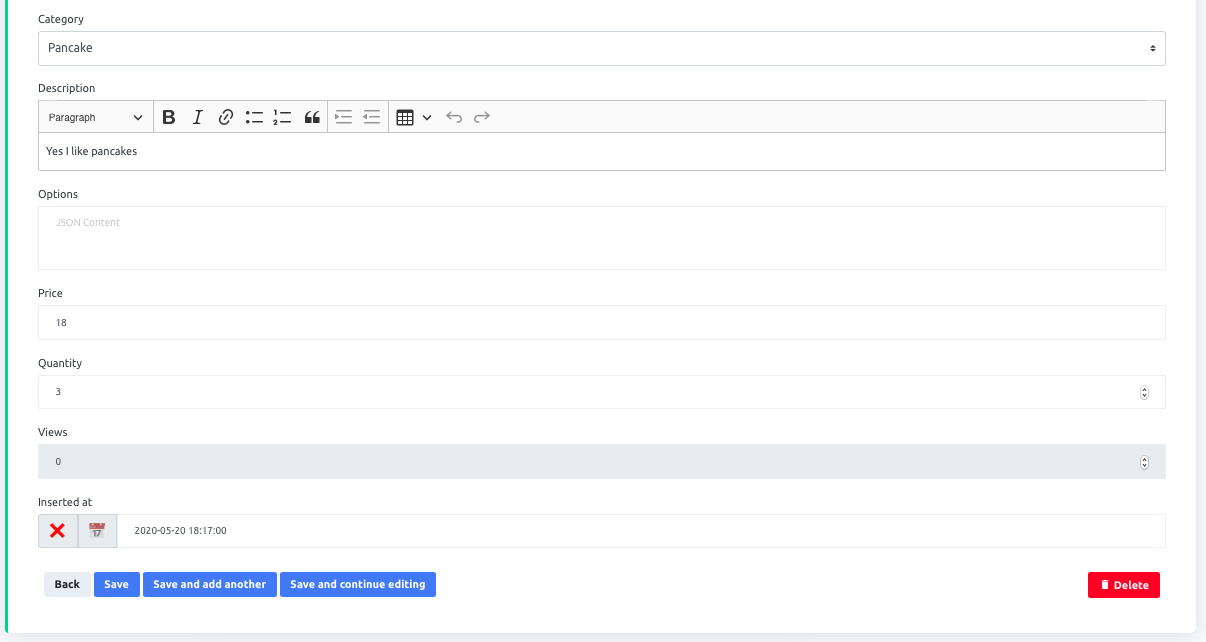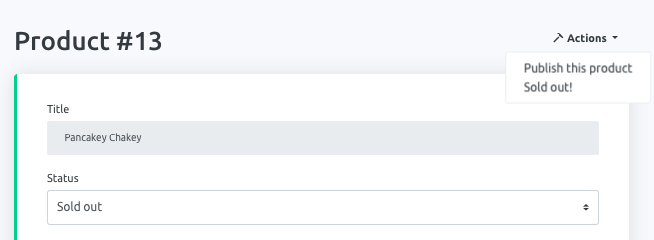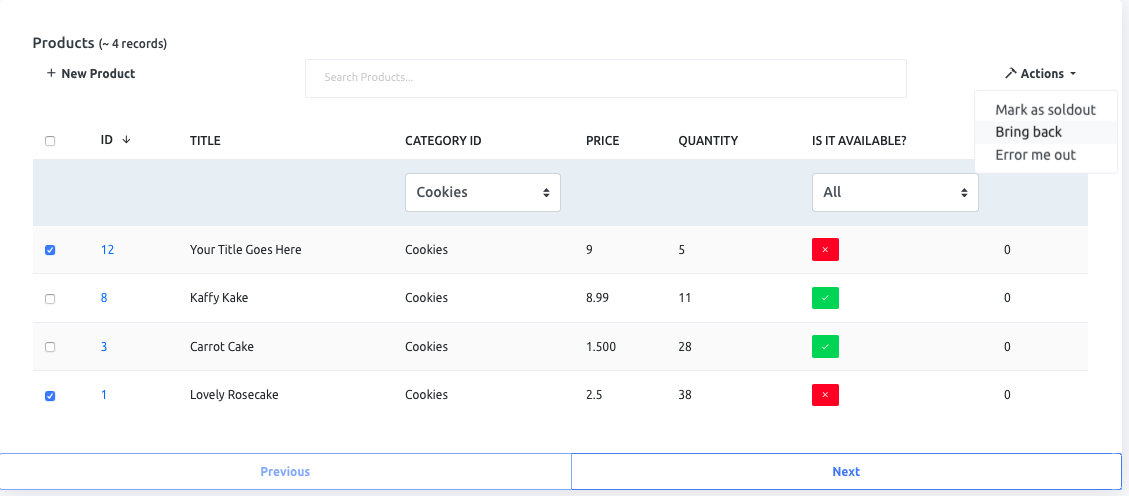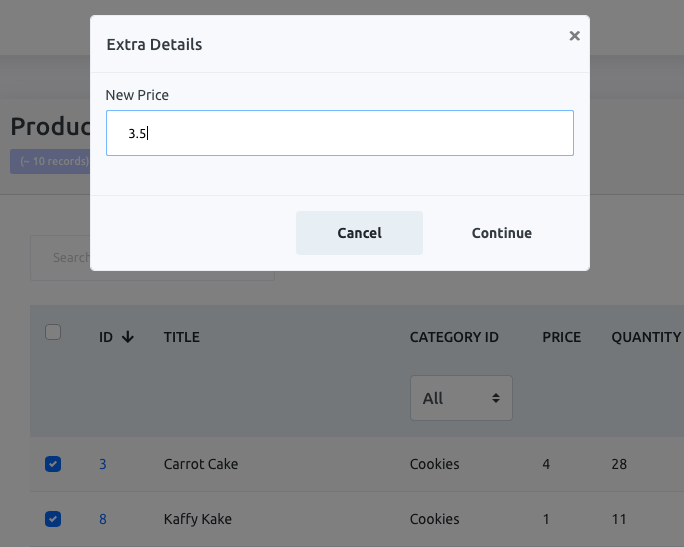Kaffy was created out of a need to have a powerfully simple, flexible, and customizable admin interface
without the need to touch the current codebase. It was inspired by django's lovely built-in admin app and rails' powerful activeadmin gem.
- Introduction
- Sections
- Sponsors
- Demo
- Minimum Requirements
- Installation
- Customizations
- The Driving Points
Sponsor the development of Kaffy through GitHub Sponsors.
Check out the simple demo here
Starting with v0.10.0, Kaffy will officially support the latest two phoenix versions.
| Kaffy | Supported phoenix versions |
|---|---|
| v0.10.0 | 1.6, 1.7.0 |
| v0.9.X | 1.5, 1.6, 1.7.0 |
The latest released major.minor version will be supported. For example, if the latest version is 0.9.0, then 0.9.1 will be released with bug fixes. If a new version 0.10.0 is released, then 0.9.1 will no longer receive bug fixes or security patches.
def deps do
[
{:kaffy, "~> 0.10.0"}
]
endIf you are using kaffy v0.9.x with phoenix 1.7, you need to add phoenix_view to your dependencies:
def deps do
[
{:phoenix_view, "~> 2.0.2"},
{:kaffy, "~> 0.9.4"}
]
end# in your router.ex
use Kaffy.Routes, scope: "/admin", pipe_through: [:some_plug, :authenticate]
# :scope defaults to "/admin"
# :pipe_through defaults to kaffy's [:kaffy_browser]
# when providing pipelines, they will be added after :kaffy_browser
# so the actual pipe_through for the previous line is:
# [:kaffy_browser, :some_plug, :authenticate]
# in your endpoint.ex
# configure the path to your application static assets in :at
# the path must end with `/kaffy`
plug Plug.Static,
at: "/kaffy", # or "/path/to/your/static/kaffy"
from: :kaffy,
gzip: false,
only: ~w(assets)
# in your config/config.exs
config :kaffy,
# required keys
otp_app: :my_app, # required
ecto_repo: MyApp.Repo, # required
router: MyAppWeb.Router, # required
# optional keys
admin_title: "My Awesome App",
admin_logo: [
url: "https://example.com/img/logo.png",
style: "width:200px;height:66px;"
],
admin_logo_mini: "/images/logo-mini.png",
hide_dashboard: true,
home_page: [schema: [:accounts, :user]],
enable_context_dashboards: true, # since v0.10.0
admin_footer: "Kaffy © 2023" # since v0.10.0Note that providing pipelines with the :pipe_through option will add those pipelines to kaffy's :kaffy_browser pipeline which is defined as follows:
pipeline :kaffy_browser do
plug :accepts, ["html", "json"]
plug :fetch_session
plug :fetch_flash
plug :protect_from_forgery
plug :put_secure_browser_headers
endNote that if you use Phoenix version 1.7 you also need to manually add the use of phoenix views in your project. Follow the instructions at https://hexdocs.pm/phoenix_view/Phoenix.View.html
You will also need to change helpers: false to true in the myapp_web.ex file as shown in example below.
# lib/myapp_web.ex
def router do
quote do
use Phoenix.Router, helpers: true # <- set to trueIf you're upgrading from an earlier version to v0.9, you need to replace your :schemas with :resources.
If you don't specify a resources option in your configs, Kaffy will try to auto-detect your schemas and your admin modules. Admin modules should be in the same namespace as their respective schemas in order for kaffy to detect them. For example, if you have a schema MyApp.Products.Product, its admin module should be MyApp.Products.ProductAdmin.
Otherwise, if you'd like to explicitly specify your schemas and their admin modules, you can do like the following:
# config.exs
config :kaffy,
admin_title: "My Awesome App",
admin_logo: "/images/logo.png",
admin_logo_mini: "/images/logo-mini.png",
admin_footer: "Kaffy © 2023",
hide_dashboard: false,
enable_context_dashboards: true,
home_page: [kaffy: :dashboard],
ecto_repo: MyApp.Repo,
router: MyAppWeb.Router,
resources: &MyApp.Kaffy.Config.create_resources/1
# in your custom resources function
defmodule MyApp.Kaffy.Config do
def create_resources(_conn) do
[
blog: [
name: "My Blog", # a custom name for this context/section.
resources: [ # this line used to be "schemas" in pre v0.9
post: [schema: MyApp.Blog.Post, admin: MyApp.SomeModule.Anywhere.PostAdmin],
comment: [schema: MyApp.Blog.Comment],
tag: [schema: MyApp.Blog.Tag, in_menu: false]
]
],
inventory: [
name: "Inventory",
resources: [
category: [schema: MyApp.Products.Category, admin: MyApp.Products.CategoryAdmin],
product: [schema: MyApp.Products.Product, admin: MyApp.Products.ProductAdmin]
]
]
]
end
endStarting with Kaffy v0.9, the :resources option can take a literal list or a function.
If a function is provided, it should take a conn and return a list of contexts and schemas like in the example above.
Passing a conn to the function provides more flexibility and customization to your resources list.
You can set the :hide_dashboard option to true to hide the dashboard link from the side menu.
To change the home page, change the :home_page option to one of the following:
[kaffy: :dashboard]for the default dashboard page.[schema: ["blog", "post"]]to make the home page the index page for thePostschema under the 'Blog' context.[page: "my-custom-page"]to make the custom page with the:slug"my-custom-page" the home page. See the Custom Pages section below.
Note that, for auto-detection to work properly, schemas in different contexts should have different direct "prefix" namespaces. That is:
# auto-detection works properly with this:
MyApp.Posts.Post
MyApp.Posts.Category
MyApp.Products.Product
MyApp.Products.Category # this Category will not be confused with Posts.Category
# auto-detection will be confused with this:
# both Category schemas have the same "Schemas" prefix.
MyApp.Posts.Schemas.Post
MyApp.Posts.Schemas.Category
MyApp.Products.Schemas.Product
MyApp.Products.Schemas.Category
# To fix this, define resources manually:
resources: [
posts: [
resources: [
post: [schema: MyApp.Posts.Schemas.Post],
category: [schema: MyApp.Posts.Schemas.Category]
]
],
products: [
resources: [
product: [schema: MyApp.Products.Schemas.Product],
category: [schema: MyApp.Products.Schemas.Category]
]
]
]Kaffy supports dashboard customizations through widgets.
Currently, kaffy provides support for 4 types of widgets:
textwidgets. Suitable for display relatively long textual information. Candidates: a short review, a specific message for the admin, etc.tidbitwidgets. Suitable for tiny bits of information (one word, or one number). Cadidates: total sales, a specific date, system status ("Healthy", "Down"), etc.progresswidgets. Suitable for measuring progress in terms of percentages. Candidates: task progress, survey results, memory usage, etc.chartwidgets. Suitable for displaying chart data with X and Y values. Candidates: any measurable number over a period of time (e.g. sales, visits, etc).
Widgets have shared options:
:type(required) is the type of the widget. Valid options aretext,tidbit,progress, andchart.:title(required) is the title for the widget. What this widget is about.:content(required) is the main content of the widget. This can be a string or a map depending on the type of widget.:order(optional) is the displaying order of the widget. Widgets are display in order based on this value. The default value is 999.:width(optional) is the width the widget should occupy on the page. Valid values are 1 to 12. The default for tidbits is 3 and the others 6.:percentage(required for progress widgets) is the percentage value for the progress. This must be an integer.:full_icon(optional for tidbit widgets) is the icon displayed next to the tidbit'scontent. You have to specify the full name given by FontAwesome likefas fa-thumbs-up.:icon(optional for tidbit widgets) is the icon displayed next to the tidbit'scontent. Any FontAwesome-valid icon is valid here. For example:thumbs-up. But it's limited to thefasgroup. For full defintion see:full_icon.
When defining a chart widget, the content must be a map with the following required keys:
:xmust be a list of values for the x-axis.:ymust be a list of numbers (integers/floats) for the y-axis.:y_titlemust be a string describing:y(e.g. USD, Transactions, Visits, etc)
To create widgets, define widgets/2 in your admin modules.
widgets/2 takes a schema and a conn and must return a list of widget maps:
defmodule MyApp.Products.ProductAdmin do
def widgets(_schema, _conn) do
[
%{
type: "tidbit",
title: "Average Reviews",
content: "4.7 / 5.0",
icon: "thumbs-up",
order: 1,
width: 6,
},
%{
type: "progress",
title: "Pancakes",
content: "Customer Satisfaction",
percentage: 79,
order: 3,
width: 6,
},
%{
type: "chart",
title: "This week's sales",
order: 8,
width: 12,
content: %{
x: ["Mon", "Tue", "Wed", "Thu", "Today"],
y: [150, 230, 75, 240, 290],
y_title: "USD"
}
}
]
end
endKaffy will collect all widgets from all admin modules and orders them based on the :order option if present and displays them on the dashboard page.
Kaffy provides support for adding custom links to the side navigation menu.
defmodule MyApp.Products.ProductAdmin do
def custom_links(_schema) do
[
%{name: "Source Code", url: "https://example.com/repo/issues", order: 2, location: :top, icon: "paperclip"},
%{name: "Products On Site", url: "https://example.com/products", location: :sub, target: "_blank"},
%{name: "Support us", url: "https://example.com/products", location: :bottom, target: "_blank", icon: "usd"},
]
end
endcustom_links/1 takes a schema and should return a list of maps with the following keys:
:nameto display as the text for the link.:urlto contain the actual URL.:methodthe method to use with the link.:orderto hold the displayed order of this link. All:sublinks are ordered under the schema menu item directly before the following schema.:locationcan be either:sub,:topor:bottom.:submeans it's under the schema sub-item.:topmeans it's displayed at the top of the menu below the "Dashboard" link.:bottommeans it's displayed at the bottom of the menu below the last context menu item. Links are ordered based on the:ordervalue. The default value is:sub.:iconis the icon displayed next to the link. Any FontAwesome-valid icon is valid here. For example:paperclip.:targetto contain the target to open the link:_blankor_self._blankwill open the link in a new window/tab,_selfwill open the link in the same window. The default value is_self.
Kaffy allows you to add custom pages like the following:
To add custom pages, you need to define the custom_pages/2 function in your admin module:
defmodule MyApp.Products.ProductAdmin do
def custom_pages(_schema, _conn) do
[
%{
slug: "my-own-thing",
name: "Secret Place",
view: MyAppWeb.ProductView,
template: "custom_product.html",
assigns: [custom_message: "one two three"],
order: 2
}
]
end
endThe custom_pages/2 function takes a schema and a conn and must return a list of maps corresponding to pages.
The maps have the following keys:
:slugto indicate the url of the page, e.g.,/admin/p/my-own-thing.:namefor the name of the link on the side menu.:viewto set the view from your own app.:templateto set the custom template you want to render in Kaffy's layout.:assigns(optional) to hold the assigns for the template. Default to an empty list.:orderis the order of the page among other pages in the side menu.
The index/1 function takes a schema and must return a keyword list of fields and their options.
If the options are nil, Kaffy will use default values for that field.
If this function is not defined, Kaffy will return all fields with their respective values.
defmodule MyApp.Blog.PostAdmin do
def popular?(p) do
if (p.popular), do: "✅", else: "❌"
end
def index(_) do
[
title: nil,
views: %{name: "Hits"},
date: %{name: "Date Added", value: fn p -> p.inserted_at end},
popular: %{name: "Popular?", value: fn p -> popular?(p) end},
]
end
endResult
Notice that the keyword list keys don't necessarily have to be schema fields as long as you provide a :value option.
You can also provide some basic column-based filtration by providing the :filters option:
defmodule MyApp.Products.ProductAdmin do
def index(_) do
[
title: nil,
category_id: %{
value: fn p -> get_category!(p.category_id).name end,
filters: Enum.map(list_categories(), fn c -> {c.name, c.id} end)
},
price: %{value: fn p -> Decimal.to_string(p.price) end},
quantity: nil,
status: %{
name: "Is it available?",
value: fn p -> available?(p) end,
filters: [{"Available", "available"}, {"Sold out", "soldout"}]
},
views: nil
]
end
end:filters must be a list of tuples where the first element is a human-frieldy string and the second element is the actual field value used to filter the records.
Result
If you need to change the order of the records, define ordering/1:
defmodule MyApp.Blog.PostAdmin do
def ordering(_schema) do
# order posts based on views
[desc: :views]
end
endIf you need to hide the "New " button, you can define the default_actions/1 function in your admin module:
defmodule MyApp.Blog.PostAdmin do
def default_actions(_schema) do
# default actions are [:new, :edit, :delete] by default.
[:delete] # cannot create or edit posts, can only delete.
end
endKaffy treats the show and edit pages as one, the form page.
To customize the fields shown in this page, define a form_fields/1 function in your admin module.
defmodule MyApp.Blog.PostAdmin do
def form_fields(_) do
[
title: nil,
status: %{choices: [{"Publish", "publish"}, {"Pending", "pending"}]},
body: %{type: :textarea, rows: 4},
views: %{create: :hidden, update: :readonly},
settings: %{label: "Post Settings"},
slug: %{help_text: "Define your own slug for the post, if empty one will be created for you using the post title."}
]
end
endThe form_fields/1 function takes a schema and should return a keyword list of fields and their options.
The keys of the list must correspond to the schema fields.
Options can be:
:label- must be a string.:type- can be any ecto type in addition to:file,:textarea, and:richtext.:rows- an integer to indicate the number of rows for textarea fields.:choices- a keyword list of option and values to restrict the input values that this field can accept.:create- can be:editablewhich means it can be edited when creating a new record, or:readonlywhich means this field is visible when creating a new record but cannot be edited, or:hiddenwhich means this field shouldn't be visible when creating a new record. It is:editableby default.:update- can be:editablewhich means it can be edited when updating an existing record, or:readonlywhich means this field is visible when updating a record but cannot be edited, or:hiddenwhich means this field shouldn't be visible when updating record. It is:editableby default.:help_text- extra "help text" to be displayed with the form field.:values_fn- This allows passing in a function to populate the list of possible values for a:arrayfield. The field will be rendered as a multi-select input. The function should be of arity 2 and the arguments are the entity and the conn. See example below
Result
Notice that:
- Even though the
statusfield is of type:string, it is rendered as a<select>element with choices. - The
viewsfield is rendered as "readonly" because it was set as:readonlyfor the update form. settingsis an embedded schema. That's why it is rendered as such.
Setting a field's type to :richtext will render a rich text editor.
The :values_fn is passed the entity you are editing and the conn (in that order) and must return a list of tuples that represent the {name, value} to use in the multi select. An example of this is as follows:
def form_fields(_schema) do
[
....
some_array_field: %{
values_fn: fn entity, conn ->
some_values = MyApp.Thing.fetch_values(entity.id, conn)
Enum.map(some_values, &{&1.name, &1.id})
end
}
]
endIf you don't want users to be able to edit or delete records, you can define the default_actions/1 function in your admin module:
defmodule MyApp.Blog.PostAdmin do
def default_actions(_schema) do
# default actions are [:new, :edit, :delete] by default.
[:new] # only create records, cannot edit or delete.
end
endA belongs_to association should be referenced by the field name, not the association name. For example, a schema with the following association:
schema "my_model" do
...
belongs_to :owner, App.Owners.Owner
...
endWould define form_fields/1 like so:
def form_fields(_) do
[
...
owner_id: nil,
...
]
endNOTE: many_to_many associations are currently not supported.
You can create your own form fields very easily with Kaffy.
Just follow the instructions on how to create a custom type for ecto and add 2 additional functions to the module:
render_form/5 and render_index/3.
Check the below example or a better example on the comments of this issue.
defmodule MyApp.Kaffy.URLField do
use Ecto.Type
def type, do: :string
# casting input from the form and making it "storable" inside the database column (:string)
def cast(url) when is_map(url) do
name = Map.get(url, "one")
link = Map.get(url, "two")
{:ok, ~s(<a href="#{link}">#{name}</a>)}
end
# if the input is not a string, return an error
def cast(_), do: :error
# loading the raw value from the database and turning it into a expected data type for the form
def load(data) when is_binary(data) do
[[_, link]] = Regex.scan(~r/href="(.*)"/, data)
[[_, name]] = Regex.scan(~r/>(.*)</, data)
{:ok, %{"one" => name, "two" => link}}
end
# this function should return the HTML related to rendering the customized form field.
def render_form(_conn, changeset, form, field, _options) do
[
{:safe, ~s(<div class="form-group">)},
Phoenix.HTML.Form.label(form, field, "Web URL"),
Phoenix.HTML.Form.text_input(form, field,
placeholder: "This is a custom field",
class: "form-control",
name: "#{form.name}[#{field}][one]",
id: "#{form.name}_#{field}_one",
value: get_field_value(changeset, field, "one")
),
Phoenix.HTML.Form.text_input(form, field,
placeholder: "This is a custom field",
class: "form-control",
name: "#{form.name}[#{field}][two]",
id: "#{form.name}_#{field}_two",
value: get_field_value(changeset, field, "two")
),
{:safe, ~s(</div>)}
]
end
# this is how the field should be rendered on the index page
def render_index(resource, field, _options) do
case Map.get(resource, field) do
nil ->
""
details ->
name = details["one"]
link = details["two"]
{:safe, ~s(<a href="#{link}">#{name}</a>)}
end
end
defp get_field_value(changeset, field, subfield) do
field_value = Map.get(changeset.data, field)
Map.get(field_value || %{}, subfield, "")
end
endBy default Kaffy does a simple Ecto query to retrieve records. You can customize the queries used by Kaffy by using custom_index_query and custom_show_query. This allows you to preload associations to display associated data on your pages, for example. Attempting to access an association without preloading it first will result in a Ecto.Association.NotLoaded exception.
defmodule MyApp.Blog.PostAdmin do
def custom_index_query(_conn, _schema, query) do
from(r in query, preload: [:tags])
end
def custom_show_query(_conn, _schema, query) do
case user_is_admin?(conn) do
true -> from(r in query, preload: [:history])
false -> query
end
end
endThe custom_index_query/3 function takes a conn, the schema, and the query to customize, and it must return a query.
It is called when fetching the resources for the index page.
The custom_show_query/3 is identifical to custom_index_query/3, but works when fetching a single resource in the show/edit page.
It's also possible to pass opts to the Repo operation, in this case, you just have to return a tuple instead, like below:
defmodule MyApp.Accounts.TenantAdmin do
def custom_index_query(_conn, _schema, query) do
{query, skip_tenant_id: true}
end
def custom_show_query(_conn, _schema, query) do
{query, skip_tenant_id: true}
end
endExtensions allow you to define custom CSS, JavaScript, and HTML. For example, you need to use a specific JavaScript library or customize the look and feel of Kaffy. This is where extensions come in handy.
Extensions are elixir modules which special functions.
defmodule MyApp.Kaffy.Extension do
def stylesheets(_conn) do
[
{:safe, ~s(<link rel="stylesheet" href="/kaffy/somestyle.css" />)}
]
end
def javascripts(_conn) do
[
{:safe, ~s(<script src="https://example.com/javascript.js"></script>)}
]
end
endThere are currently 2 special functions supported in extensions: stylesheets/1 and javascripts/1.
Both functions take a conn and must return a list of safe strings.
stylesheets/1 will add whatever you include at the end of the <head> tag.
javascripts/1 will add whatever you include there just before the closing </body> tag.
Once you have your extension module, you need to add it to the extensions list in config:
config :kaffy,
# other settings
extensions: [
MyApp.Kaffy.Extension
]You can check this issue to see an example which uses extensions with custom fields.
Kaffy has support for Ecto's embedded schemas and JSON fields. When you define a field as a :map, Kaffy will automatically display a textarea with a placeholder to hint that JSON content is expected. When you have an embedded schema, Kaffy will try to render each field inline with the form of the parent schema.
Kaffy provides very basic search capabilities.
Supported field types are: :string, :textarea, :richtext, :id, :integer, and :decimal.
If you need to customize the list of fields to search against, define the search_fields/1 function.
defmodule MyApp.Blog.PostAdmin do
def search_fields(_schema) do
[:id, :title, :body, :views]
end
endKaffy allows to search for fields across associations. The following tells Kaffy to search posts by title and body and category's name and description:
# Post has a belongs_to :category association
defmodule MyApp.Blog.PostAdmin do
def search_fields(_schema) do
[
:title,
:body,
:view,
category: [:name, :description]
]
end
endThis function takes a schema and returns a list of schema fields that you want to search.
If this function is not defined, Kaffy will return all fields with supported types by default.
Kaffy supports basic authorization for individual schemas by defining authorized?/2.
defmodule MyApp.Blog.PostAdmin do
def authorized?(_schema, conn) do
MyApp.Blog.can_see_posts?(conn.assigns.user)
end
endauthorized?/2 takes a schema and a Plug.Conn struct and should return a boolean value.
If it returns false, the request is redirected to the dashboard with an unauthorized message.
Note that the resource is also removed from the resources list if authorized?/2 returns false.
Kaffy supports separate changesets for creating and updating schemas.
Just define create_changeset/2 and update_changeset/2.
Both of them are passed the schema and the attributes.
defmodule MyApp.Blog.PostAdmin do
def create_changeset(schema, attrs) do
# do whatever you want, must return a changeset
MyApp.Blog.Post.my_customized_changeset(schema, attrs)
end
def update_changeset(entry, attrs) do
# do whatever you want, must return a changeset
MyApp.Blog.Post.update_changeset(entry, attrs)
end
endIf either function is not defined, Kaffy will try calling Post.changeset/2.
And if that is not defined, Ecto.Changeset.change/2 will be called.
Kaffy makes some effor to guess a correct plural form of the resource, but in some cases it will fail. Should this happen, you may want to set a correct name yourself.
This is why singular_name/1 and plural_name/1 are there.
defmodule MyApp.Blog.PostAdmin do
def singular_name(_) do
"Article"
end
def plural_name(_) do
"Terms"
end
endKaffy supports performing custom actions on single resources by defining the resource_actions/1 function.
defmodule MyApp.Blog.ProductAdmin
def resource_actions(_conn) do
[
publish: %{name: "Publish this product", action: fn _c, p -> restock(p) end},
soldout: %{name: "Sold out!", action: fn _c, p -> soldout(p) end}
]
end
defp restock(product) do
update_product(product, %{"status" => "available"})
end
defp soldout(product) do
case product.id == 3 do
true ->
{:error, product, "This product should never be sold out!"}
false ->
update_product(product, %{"status" => "soldout"})
end
endResult
resource_actions/1 takes a conn and must return a keyword list.
The keys must be atoms defining the unique action "keys".
The values are maps providing a human-friendly :name and an :action that is an anonymous function with arity 2 that takes a conn and the record.
Actions must return one of the following:
{:ok, record}indicating the action was performed successfully.{:error, changeset}indicating there was a validation error.{:error, record, custom_error}to communicate a custom error message to the user wherecustom_erroris a string.
Kaffy also supports actions on a group of resources. You can enable list actions by defining list_actions/1.
defmodule MyApp.Products.ProductAdmin do
def list_actions(_conn) do
[
change_price: %{
name: "Change the price",
inputs: [
%{name: "new_price", title: "New Price", default: "3"}
],
action: fn _conn, products, params -> change_price(products, params) end
},
soldout: %{name: "Mark as soldout", action: fn _, products -> list_soldout(products) end},
restock: %{name: "Bring back", action: fn _, products -> bring_back(products) end},
not_good: %{name: "Error me out", action: fn _, _ -> {:error, "Expected error"} end}
]
end
defp change_price(products, params) do
new_price = Map.get(params, "new_price") |> Decimal.new()
Enum.map(products, fn p ->
Ecto.Changeset.change(p, %{price: new_price})
|> Bakery.Repo.update()
end)
:ok
end
endResult
list_actions/1 takes a conn and must return a keyword list.
The keys must be atoms defining the unique action "keys".
The values are maps providing a human-friendly :name and an :action that is an anonymous function with arity 2 that takes a conn and a list of selected records.
The change_price action is a multi-step action.
The defined :inputs option will display a popup with a form that contains defined in this option.
:inputs should be a list of maps. Each input must have a :name and a :title.
An optional key in the input map is :use_select, which defaults to false.
If true, the input becomes a select instead by using a passed in list called :options, which is a list of lists formatted like so [[display, value], [display, value]].
If false, a :default value is required for the text input.
After submitting the popup form, the extra values, along with the selected resources, are passed to the :action function.
In the example above, change_price/2 will receive the selected products with a map of extra inputs, like: %{"new_price" => "3.5"} for example.
List actions must return one of the following:
:okindicating the action was performed successfully.{:error, custom_error}to communicate a custom error message to the user wherecustom_erroris a string.
Sometimes you need to execute certain actions when creating, updating, or deleting records.
Kaffy has your back.
There are a few callbacks that are called every time you create, update, or delete a record.
These callbacks are:
before_insert/2before_update/2before_delete/2before_save/2after_save/2after_delete/2after_update/2after_insert/2
before_* functions are passed the current conn and a changeset. after_* functions are passed the current conn and the record itself. With the exception of before_delete/2 and after_delete/2 which are both passed the current conn and the record itself.
before_(create|save|update)/2must return{:ok, changeset}to continue.before_delete/2must return{:ok, record}to continue.- All
after_*functions must return{:ok, record}to continue.
To prevent the chain from continuing and roll back any changes:
before_(create|save|update)/2must return{:error, changeset}.before_delete/2must return{:error, record, "Customized error message}.- All
after_*functions must return{:error, record, "Customized error message"}.
When creating a new record, the following functions are called in this order:
before_insert/2before_save/2- inserting the record happens here:
Repo.insert/1 after_save/2after_insert/2
When updating an existing record, the following functions are called in this order:
before_update/2before_save/2- updating the record happens here:
Repo.update/1 after_save/2after_update/2
When deleting a record, the following functions are called in this order:
before_delete/2- deleting the record happens here:
Repo.delete/1 after_delete/2
It's important to know that all callbacks are run inside a transaction. So in case of failure, everything is rolled back even if the operation actually happened.
defmodule MyApp.Blog.PostAdmin do
def before_insert(conn, changeset) do
case conn.assigns.user.username == "aesmail" do
true -> {:error, changeset} # aesmail should never create a post
false -> {:ok, changeset}
end
end
def after_insert(_conn, post) do
{:error, post, "This will prevent posts from being created"}
end
def before_delete(conn, post) do
case conn.assigns.user.role do
"admin" -> {:ok, post}
_ -> {:error, post, "Only admins can delete posts"}
end
end
endSometimes you may need to overwrite the way Kaffy is creating, updating, or deleting records.
You can define you own Admin function to perform those actions. This can be useful if you are creating complex records, importing files, etc...
The function that can be overwritten are:
insert/2update/2delete/2
insert/2, update/2 & delete/2 functions are passed the current conn and a changeset.
They must return {:ok, record} to continue.
defmodule MyApp.Blog.PostAdmin do
def insert(conn, changeset) do
entry = Post.create_complex_post(conn.params)
{:ok, entry}
end
def update(conn, changeset) do
entry = Post.update_complex_post(conn.params["id"])
{:ok, entry}
end
def delete(conn, changeset) do
entry = Post.delete_complex_post(conn.params["id"])
{:ok, entry}
end
endKaffy supports simple scheduled tasks. Tasks are functions that are run periodically. Behind the scenes, they are put inside GenServers and supervised with a DynamicSupervisor.
To setup scheduled tasks, first define a task_[task_name]/1 function in your admin module that returns a list of tasks:
defmodule MyApp.Products.ProductAdmin do
def task_products do
[
%{
name: "Cache Product Count",
initial_value: 0,
every: 15,
action: fn _v ->
count = Bakery.Products.cache_product_count()
# "count" will be passed to this function in its next run.
{:ok, count}
end
},
%{
name: "Delete Fake Products",
every: 60,
initial_value: nil,
action: fn _ ->
Bakery.Products.delete_fake_products()
{:ok, nil}
end
}
]
end
endOnce this is done, add the admin module to the scheduled_tasks option in your config:
config :kaffy,
...
scheduled_tasks: [
MyApp.Products.ProductAdmin
]A new "Tasks" menu item will show up (below the Dashboard item) with your tasks as well as some tiny bits of information about each task like the following image:
The task_[task_name]/1 function takes a schema and must return a list of tasks.
A task is a map with the following keys:
:nameto hold a short description for the task.:initial_valueto pass to the task's action in its first run.:everyto indicate the number of seconds between each run.:actionto hold an anonymous function with arity/1.
The initial_value is passed to the action function in its first run.
The action function must return one of the following values:
{:ok, value}which indicates a successful run. Thevaluewill be passed to theactionfunction in its next run.{:error, value}which indicates a failed run. Thevaluewill be saved and passed again to theactionfunction in its next run.
If the action function crashes, the task will be brought back up again in its initial state that is defined in the task_[task_name]/1 function and the "Started" time will change to indicate the new starting time. This will also reset the successful and failed run counts to 0.
Note that since scheduled tasks are run with GenServers, they are stored and kept in memory. Having too many scheduled tasks under low memory conditions can cause an out of memory exception.
Scheduled tasks should be used for simple, non-critical operations.
A few points that encouraged the creation and development of Kaffy:
- Taking contexts into account.
- Supporting contexts makes the admin interface better organized.
- Can handle as many schemas as necessary.
- Whether we have 1 schema or 1000 schemas, the admin interface should adapt well.
- Have a visually pleasant user interface.
- This might be subjective.
- No generators or generated templates.
- I believe the less files there are the better. This also means it's easier to upgrade for users when releasing new versions. This might mean some flexibility and customizations will be lost, but it's a trade-off.
- Existing schemas/contexts shouldn't have to be modified.
- I shouldn't have to change my code in order to adapt to the package, the package should adapt to my code.
- Should be easy to use whether with a new project or with existing projects with a lot of schemas.
- Adding kaffy should be as easy for existing projects as it is for new ones.
- Highly flexible and customizable.
- Provide as many configurable options as possible.
- As few dependencies as possible.
- Currently kaffy only depends on Phoenix and Ecto.
- Simple authorization.
- I need to limit access for some admins to some schemas.
- Sensible, modifiable, default assumptions.
- When the package assumes something, this assumption should be sensible and modifiable when needed.
Copyright (c) 2020 Abdullah Esmail
This work is free. You can redistribute it and/or modify it under the terms of the MIT License. See the LICENSE.md file for more details.





